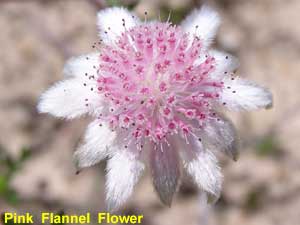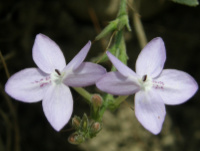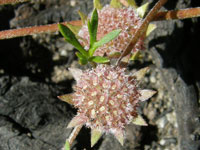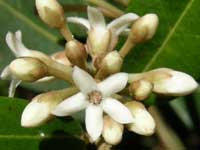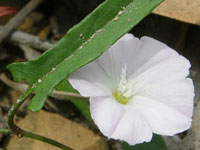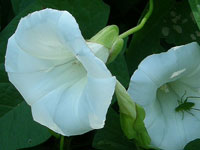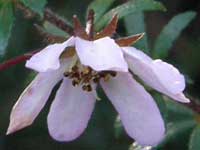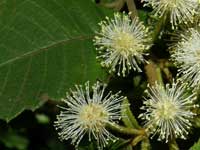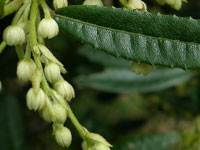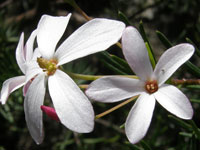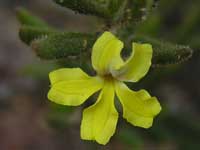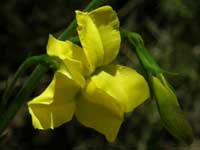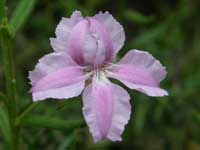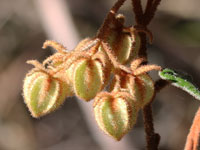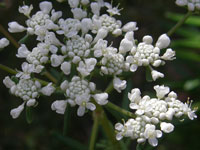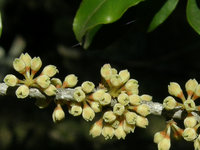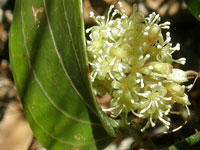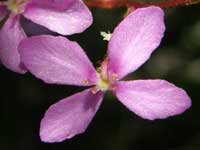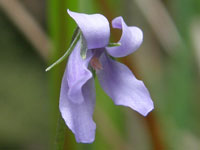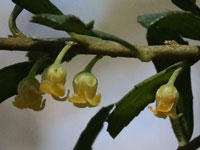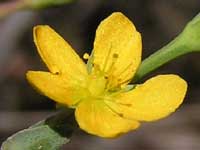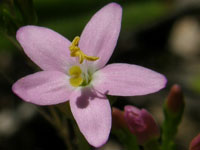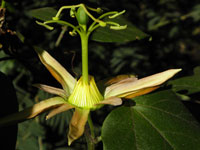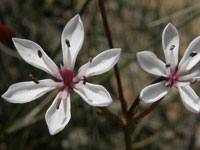We acknowledge the traditional custodians of the land on which these plants grow - the Darug and Gundungurra people - and pay respect to their Elders past, present and emerging.
This set of wildflowers is "simply" those that belong to smaller floral families - of which there are over 180 families with over 2,000 species in the Blue Mountains. This includes over 600 "introduced species" (weeds).
The largest family is the grasses - Family Poaceae - with over 280 species (including 100 weeds). However, this website doesn't cover this family - yet.
Next is the Family Asteraceae (daisies) with over 220 species (including 70 weeds).
Note: Images marked as LCNP were taken in the Lane Cove National Park.
- Andromeda Pomaderris
- Angel Sword
- Apple Berry
- Barbwire Vine
- Bearded Tylophora
- Bear's Breeches *
- Bitter Cryptandra
- Black Sassafras
- Black Wattle
- Black-eyed Susan
- Blue Dampiera
- Blue Pincushion
- Blueberry Ash
- Blunt Sandalwood
- Bridal Daisy Bush
- Broad-leaf Star Hair
- Broom Milkwort
- Broom Spurge
- Buddleja *
- Bursaria longisepala
- Button Everlasting
- Carrot Tops
- Cliff Eyebright
- Clustered Poranthera
- Common Centaury *
- Common Dog-violet *
- Common Silkpod
- Coreopsis *
- Creamy Candles
- Creeping Buttercup *
- Curly Wig
- Dandelion *
- Dolly Bush
- Drooping Mistletoe
- Dwarf Flannel Flower
- Elderberry Panax
- Fairies’ Wings
- Fireweed *
- Fireweed Groundsel
- Flatweed *
- Forest Starwort
- Forked Comb Fern
- Forked Sundew
- Goodenia decurrens
- Goodenia heterophylla subsp. heterophylla
- Goodenia heterophylla subsp. montana
- Grass Daisy
- Grass Trigger-plant
- Greater Periwinkle *
- Headache Vine
- Heath-leaved Poranthera
- Heathy Platysace
- Hop Goodenia
- Ivy Goodenia
- Japanese Honeysuckle *
- Large Bindweed
- Large Mock-olive
- Lesser Flannel Flower
- Lilac Mint Bush
- Louisa's Mistletoe
- Love Creeper
- Matchheads
- Milkmaids
- Mountain Blueberry
- Mountain Clematis *
- Mountain Silkpod
- Narrow-leaf Logania
- Narrow-leaved Mint-bush
- Narrow-leaved Triggerplant
- Native Parsnip
- Native Passionfruit
- Native Sarsaparilla
- Native Violet
- NSW Christmas Bush
- Oak-leaved Olearia
- Olax
- Old Man's Beard
- Pagoda Rock Daisy
- Pastel Flower
- Pincushion *
- Pink Flannel Flower
- Pink-tip Daisy-bush
- Pinnate Hop Bush
- Prickly Sowthistle *
- Purple Coopernookia
- Purple Dampiera
- Purple Eyebright
- Red Rusty-petals
- Rice-flower Pseudanthus
- River Rose
- Rough Daisy-bush
- Rusty Velvet-bush
- Sandstone Violet
- Satin Everlasting
- Scarlet Pimpernel *
- Scented Marsdenia
- Scotch Thistle *
- Sheoak Mistletoe
- Shoddy Ragwort
- Single Bladderwort
- Slender Bindweed
- Slender Rice Flower
- Slender Stackhousia
- Slender Violet-bush
- Small-leaved Privet *
- Small Poranthera
- Small St. John's Wort
- Snake Flower
- Spoon-leaved Sundew
- Star Xanthosia
- Sticky Daisy Bush
- Stiff Cassinia
- Sweet Pittosporum
- Sydney Flannel Flower
- Tarata *
- Thyme Mitrewort
- Thyme Spurge
- Toothed Daisy-bush
- Tree Trigger-plant
- Tree Violet
- Triggerplant
- Variable Muttonwood
- Variable-leaved Goodenia
- Varied Mitrewort
- Velvet Pink
- Wedding Bush
- White Burr Daisy
- White Paper Daisy
- White Marianth
- White Root
- White Sour Bush
- Woolly Xanthosia
- Xanthosia scopulicola
- Yellow Cassinia
* Introduced species (weed)
- Acanthus mollis *
- Actinotus forsythii
- Actinotus gibbonsii
- Actinotus helianthi
- Actinotus minor
- Amperea xiphoclada
- Amyema cambagei
- Amyema pendula subsp. pendula
- Astrotricha latifolia
- Atherosperma moschatum subsp. integrifolium
- Atkinsonia ligustrina
- Bauera rubioides
- Billardiera scandens
- Brachyscome graminea
- Brunonia australis
- Buddleja davidii *
- Burchardia umbellata
- Bursaria longisepala
- Callicoma serratifolia
- Calotis dentex
- Calystegia sepium subsp. roseata
- Cassinia aculeata subsp. aculeata
- Cassinia aureonitens
- Cassinia denticulata
- Caustis flexuosa
- Centaurium erythraea *
- Ceratopetalum gummiferum
- Choretrum candollei
- Clematis aristata
- Clematis glycinoides
- Clematis montana *
- Comesperma defoliatum
- Comesperma ericinum
- Comesperma sphaerocarpum
- Comesperma volubile
- Coopernookia barbata
- Coreopsis lanceolata *
- Coronidium elatum subsp. elatum
- Coronidium scorpioides
- Cryptandra amara
- Dampiera purpurea
- Dampiera stricta
- Dodonaea pinnata
- Drosera binata
- Drosera spatulata
- Elaeocarpus holopetalus
- Elaeocarpus reticulatus
- Euphrasia bowdeniae
- Euphrasia collina subsp. paludosa
- Goodenia decurrens
- Goodenia hederacea subsp. hederacea
- Goodenia heterophylla subsp. heterophylla
- Goodenia heterophylla subsp. montana
- Goodenia ovata
- Helichrysum leucopsideum
- Hybanthus monopetalus
- Hypericum gramineum
- Hypochaeris radicata *
- Lasiopetalum ferrugineum var. ferrugineum
- Lasiopetalum rufum
- Leucochrysum graminifolium
- Ligustrum sinense *
- Lobelia dentata
- Lobelia purpurascens
- Logania albiflora
- Lonicera japonica *
- Lysimachia arvensis *
- Marsdenia suaveolens
- Melicytus dentatus
- Mitrasacme polymorpha
- Mitrasacme serpyllifolia
- Myrsine variabilis
- Notelaea longifolia
- Olax stricta
- Olearia asterotricha subsp. glaucophylla
- Olearia elliptica subsp. elliptica
- Olearia erubescens
- Olearia microphylla
- Olearia quercifolia
- Olearia tomentosa
- Onopordum acanthium subsp. acanthium *
- Parsonsia brownii
- Parsonsia straminea
- Passiflora herbertiana subsp. herbertiana
- Petrorhagia dubia *
- Phyllanthus hirtellus
- Pimelea linifolia subsp. linoides
- Pittosporum eugenioides *
- Pittosporum undulatum
- Platysace ericoides
- Platysace lanceolata
- Platysace linearifolia
- Polymeria calycina
- Polyscias sambucifolia
- Pomaderris andromedifolia
- Poranthera corymbosa
- Poranthera ericifolia
- Poranthera microphylla
- Prostanthera caerulea
- Prostanthera linearis
- Pseudanthus pimeleoides
- Pseuderanthemum variabile
- Ranunculus repens *
- Rhytidosporum procumbens
- Ricinocarpos pinifolius
- Santalum obtusifolium
- Scabiosa atropurpurea *
- Scaevola ramosissima
- Schizaea bifida
- Senecio linearifolius var. macrodontus
- Senecio madagascariensis *
- Senecio pterophorus *
- Smilax australis
- Smilax glyciphylla
- Sonchus asper *
- Stackhousia monogyna
- Stackhousia viminea
- Stellaria flaccida
- Stylidium graminifolium
- Stylidium laricifolium
- Stylidium lineare
- Stylidium productum
- Taraxacum officinale *
- Tetratheca ericifolia
- Tetratheca rupicola
- Tylophora barbata
- Utricularia uniflora
- Vinca major *
- Viola hederacea
- Viola riviniana *
- Viola silicestris
- Xanthosia pilosa
- Xanthosia scopulicola
- Xanthosia stellata
* Introduced species (weed)
The Acanthaceae family includes some 2,500 species worldwide. There are three natives species recorded as being in the Blue Mountains - the two not shown here are Brunoniella australis (Blue Trumpet) and Brunoniella pumilio (Dwarf Blue Trumpet).
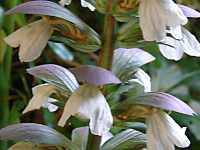
Bear's Breeches
Acanthus mollis
Its huge leaves are 50cm long and 30cm wide.
Besides flannel flowers, this family includes carrots and celery and a host of herbs such as parsley, coriander and fennel. Also see our Flannel Flowers web page.
There's 5 Actinotus species in NSW, 4 of which can be found in the Blue Mountains. The 5th, the Clustered Flannel Flower (Actinotus paddisonii), is found out west around Bourke.
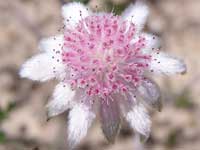
Pink Flannel Flower
Actinotus forsythii
The flowers are 20mm in diameter.
Here's another image and another.
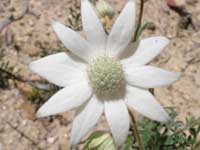
Sydney Flannel Flower
Actinotus helianthi
The forked hairy green leaves help identify it when not in flower.
The flowers are 50mm in diameter.
Here's another image.
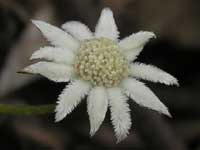
Lesser Flannel Flower
Actinotus minor
It seems to always be in flower.
Here's another image and another.
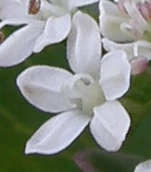
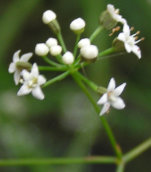
Its white/creamy/sometimes pinkish flowers are in umbels* and its petals have a ridge in the middle. Its leaves are variable.
* An umbel is where flower-stalks arise from one point at the top of a stalk.
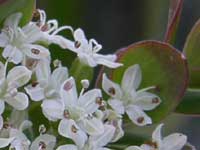
Native Parsnip
Platysace lanceolata
The mountain heath form has broad leaves. A form found in the Lane Cove National Park has lance like leaves.
Here's another image.
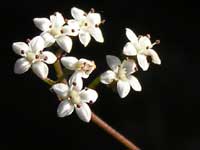
Carrot Tops
Platysace linearifolia
Its long thin leaves also helps identify it.
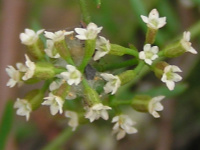
Heathy Platysace
Platysace ericoides
Its 2mm wide flowers appear in spring to autumn.
Here's another image.
The Xanthosia genus is endemic to Australia with 20 species overall with 6 found in the Blue Mountains.
Its flowers readily identify the genus, while the lobed leaves help identify the species.
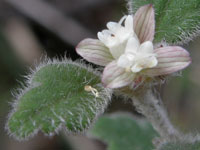
Woolly Xanthosia
Xanthosia pilosa
This image shows the underside of the leaves.
Here's another image and another and another.
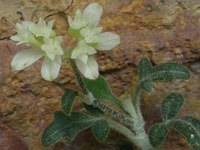
Xanthosia scopulicola
Its white flaky stems helps identify it.
Here's another image and another.
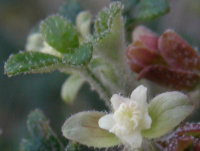
Star Xanthosia
Xanthosia stellata
Its bracts/petals become dark red.
Here's another image.
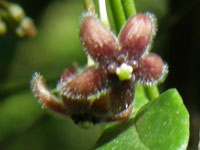
Bearded Tylophora
Tylophora barbata
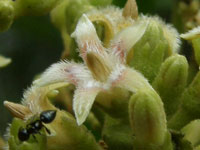
Common Silkpod
Parsonsia straminea
The leaves of P. straminea are finely reticulated.
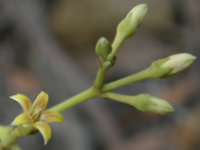
Mountain Silkpod
Parsonsia brownii
They have a hairy throat.
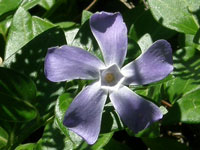
Greater Periwinkle
Vinca major
It is also known as Blue Periwinkle and Vinca.
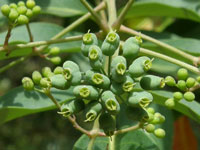
Elderberry Panax
Polyscias sambucifolia
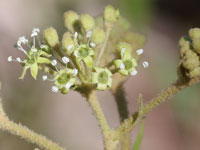
Broad-leaf Star Hair
Astrotricha latifolia
Its broad leaves can be 20cm long and 8cm wide. The flowers are 4mm wide.
Its light green petals distinguish it from A. longifolia whose petals are whitish.
The daisy family (Asteraceae) comprises around 24,000 species distributed worldwide - making it the second largest family of flowering plants in the world after the Orchidaceae (orchids) family's 25,000. They include many horticultural plants (e.g. chrysanthemum, gerbera) and crops (e.g. artichoke, lettuce, stevia, sunflower).
[source: Kew Gardens]
PlantNet shows 970 species in Australia with 225 in the Blue Mountains - a third of these being weeds.
Cassinia species are primarily endemic to Australia. With five species endemic to New Zealand. Its clustered flower heads help identify it. There are 47 species in Australia of which 8 are in the Blue Mountains.
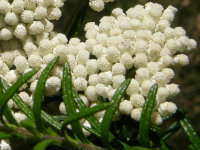
Dolly Bush
Cassinia aculeata subsp. aculeata
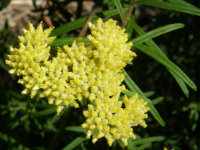
Yellow Cassinia
Cassinia aureonitens
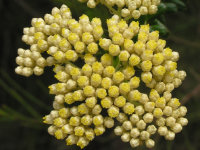
Stiff Cassinia
Cassinia denticulata
The Olearia genus is endemic to Australasia, with 112 species in Australia of which 11 are in the Blue Mountains.
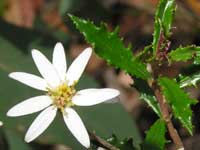
Pink-tip Daisy-bush
Olearia erubescens
The shiny prickly leaves helps identify this species, as does the redness underneath the leaves.
The newer leaves are dark red.
Here's another image.
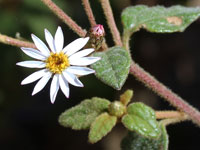
Toothed Daisy-bush
Olearia tomentosa
[mucro: a short point at the end of a leaf.]
Its leaves are around 40mm long and 20mm wide.
Here's another image and another.
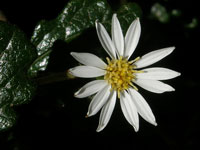
Oak-leaved Olearia
Olearia quercifolia
It is only found in the Blue Mountains.
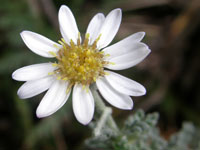
Rough Daisy-bush
Olearia asterotricha
subsp. glaucophylla
Here's another image of its leaves.
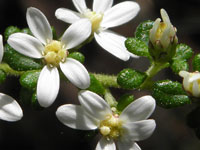
Bridal Daisy Bush
Olearia microphylla
Here's another image.
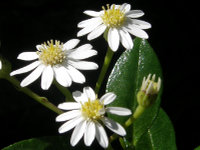
Sticky Daisy Bush
Olearia elliptica subsp. elliptica
The leaves are alternate and scattered and their stalks are 10mm long.
Here's another image and another.
The other subspecies (praetermissa) lives on Lord Howe Island.
The Senecio genus contains a staggering 1,250 species which makes it one of the largest genera of flowering plants.
There are 50 species that are native to Australia of which 12 are in the Blue Mountains.
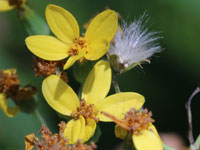
Fireweed Groundsel
Senecio linearifolius var. macrodontus
N.B. There are 23 Senecio species in the Blue Mountains - several without a description or identification key on PlantNet.
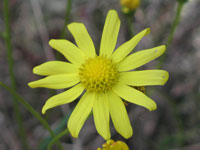
Fireweed
Senecio madagascariensis
Its 13-15 ray florets (petals) differentiates it from the native Fireweed Groundsel (Senecio linearifolius) that has 4-8.
Here's another image.
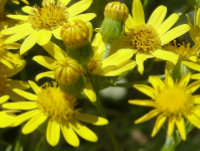
Shoddy Ragwort
Senecio pterophorus
Its variable toothed leaves are white “cobwebby” underneath.
Its 15mm wide flowers appear in summer.
Here's an image from underneath.
Other Asteraceae species
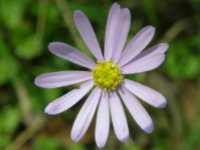
Grass Daisy
Brachyscome graminea
It flowers from spring through autumn. Its flowers are 20mm wide.
Brachyscome species are primarily endemic to Australia.
Brachyscome is spelt Brachycome in some sources.
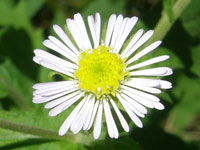
White Burr Daisy
Calotis dentex
Here's an image with a pollinator - a hover fly.
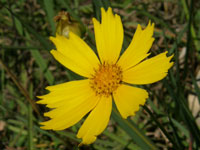
Coreopsis
Coreopsis lanceolata
The story goes that a traveller thinking that our native flora was bland, threw Coreopsis seeds from railway carriages.
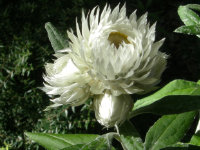
White Paper Daisy
Coronidium elatum subsp. elatum
Its leaves are a dull green on top and white underneath.
It is the only C. elatum subspecies in the Blue Mountains.
Here's another image.
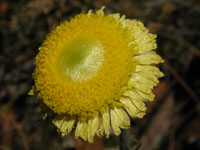
Button Everlasting
Coronidium scorpioides
It is identified by its 30mm wide flowers and a rosette of 90mm long hispid (bristly) leaves each with a mucro.
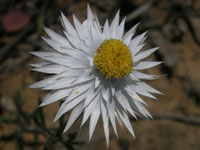
Satin Everlasting
Helichrysum leucopsideum
The flower on the left of this image is almost ready to release its seeds.
Here's an image of its leaves.
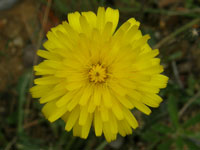
Flatweed
Hypochaeris radicata
Also known as Catsear, its cypsela (dry single-seeded fruit) is typical of most members of the Asteraceae family.
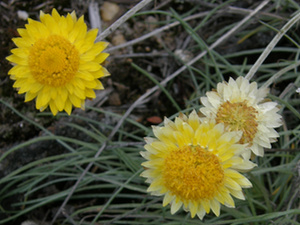
Pagoda Rock Daisy
Leucochrysum graminifolium
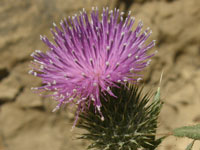
Scotch Thistle
Onopordum acanthium
subsp. acanthium
It is Scotland's floral emblem.
Here's an image of its seeds ready for take off.
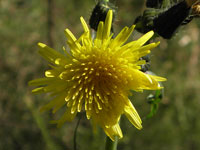
Prickly Sowthistle
Sonchus asper
As does its unique often pinnatisect (cut down to the midrib) leaves.
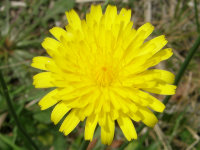
Dandelion
Taraxacum officinale
Its leaves, although in the form of a rosette, are not ground hugging.
Its flowers, which are solitary at the end of the stalk are 40mm wide and flower throughout the year.
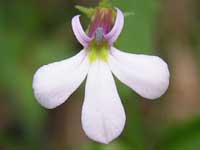
White Root
Lobelia purpurascens
The undersides of its leaves are purplish. Its 10mm flowers appear in the warmer months.
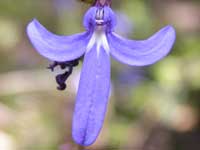
Angel Sword
Lobelia dentata
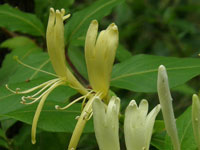
Japanese Honeysuckle
Lonicera japonica
Its toothless leaves and red stems help identify it when not in flower.
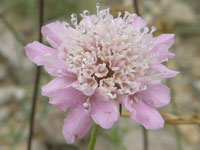
Pincushion
Scabiosa atropurpurea
A family of some 2,625 species and includes the carnation (Dianthus caryophyllus) and one of only two flowering plants found in Antarctica - Colobanthus quitensis (Antarctic Pearlwort).
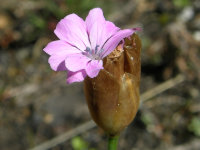
Velvet Pink
Petrorhagia dubia
A plant to 60cm in height, its leaves may help identify it.
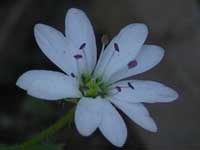
Forest Starwort
Stellaria flaccida
There's seven members of the Cunoniaceae family in our Blue Mountains Area of Interest.
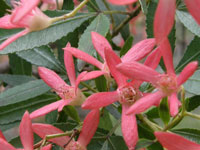
NSW Christmas Bush
Ceratopetalum gummiferum
However, the NSW Christmas Bush produces white flowers - as shown here with its pollinators. It's its sepals that turn to red in fruit.
The Droseraceae family includes the Venus Fly Trap.
Genus Drosera - SundewsThere's 12 Drosera species in NSW, of which 9 are in the Blue Mountains
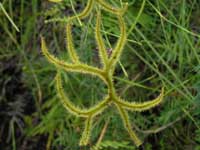
Forked Sundew
Drosera binata
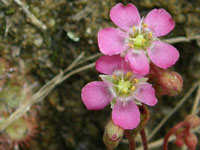
Spoon-leaved Sundew
Drosera spatulata
Genus Tetratheca - Black-eyed Susans
Genus Tetratheca formerly belonged to the Tremandraceae family. This family has now been absorbed into the Elaeocarpaceae family.
The NSW Flora Online describes some 14 species that occur in New South Wales. The species are collectively called Black-eyed Susans, and their similarity to each other provides a real challenge in identifying them.
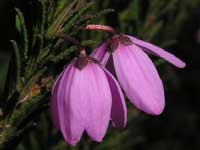
Black-eyed Susan
Tetratheca ericifolia
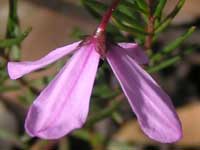
Black-eyed Susan
Tetratheca rupicola
There are 9 species in NSW with 3 in the Blue Mountains. Although they all have "blueberry" in their common name, they are not part of the blueberry family. Blueberries are members of the Heath family.
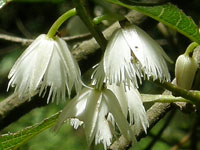
Blueberry Ash
Elaeocarpus reticulatus
(This pink variant was found in Jervis Bay.)
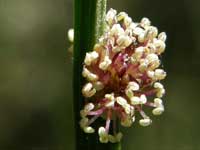
Broom Spurge
Amperea xiphoclada
There's six genera of the Goodeniaceae family in the Blue Mountains totalling over thirty species.
Genus DampieraThere's three Dampiera species recorded as being in the Blue Mountains. The one missing from my collection is Purple Beauty Bush (Dampiera adpressa).
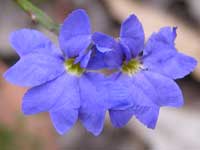
Blue Dampiera
Dampiera stricta
Also see our Blue Dampiera web page.
Here's an image of a white variant.
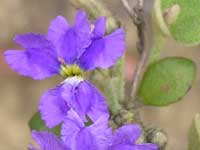
Purple Dampiera
Dampiera purpurea
Its oval leaves are also very different.
There's some fifteen Goodenia species recorded as being in the Blue Mountains. Goodenia heterophylla having three subspecies.
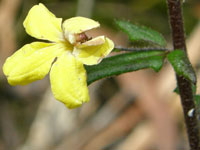
Goodenia heterophylla
subsp. heterophylla
Here's another image.
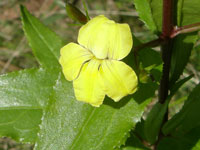
Hop Goodenia
Goodenia ovata
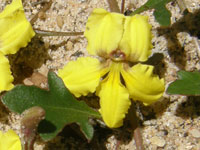
Ivy Goodenia
Goodenia hederacea subsp. hederacea
Other genera of the Goodeniaceae family
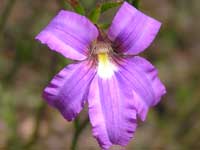
Snake Flower
Scaevola ramosissima
Here's images from side on and underneath.
Here's another image.
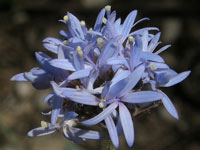
Blue Pincushion
Brunonia australis
It is found in all states, and in NSW away from the coast.
Its flowers are 15mm across.
Its basal leaves help identify it.
Here's another image.
The Lamiaceae or mint family has over 7,534 species worldwide and includes culinary herbs like basil, mint, marjoram, chia, oregano,
parsley, sage, rosemary and thyme. It also includes lavender and teak.
The 100+ species of the Prostanthera genus are endemic to Australia with 13 being recorded in the Blue Mountains. Identifying species can be difficult - and it is thought that they hybridize.
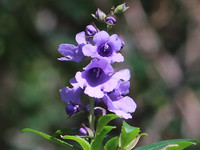
Lilac Mint Bush
Prostanthera caerulea
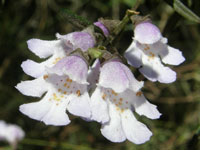
Narrow-leaved Mint-bush
Prostanthera linearis
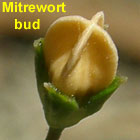
The orange flower bud is shaped like a bishop's hat - which is called a mitre - thus its name.
Missing from the gallery below are M. alsinoides, M. paludosa and M. pilosa.
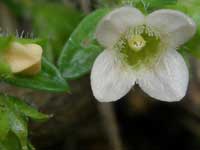
Thyme Mitrewort
Mitrasacme serpyllifolia
[The botanical word for this is "sessile".]
Its flowers are 6mm wide; its leaves are 6mm long and 2mm wide.
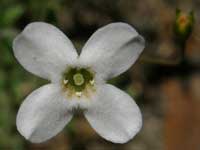
Varied Mitrewort
Mitrasacme polymorpha
It has very hairy branches and leaves.
This image shows the multiple flowers.
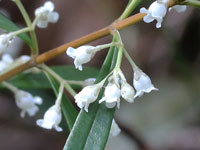
Narrow-leaf Logania
Logania albiflora
Here's another image.
Loranthaceae is a family of parasitic shrubs - both terrestrial and aerial.
There's eight species in the Blue Mountains across four genera.
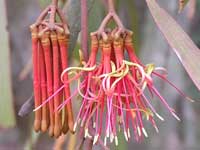
Drooping Mistletoe
Amyema pendula subsp. pendula
Its flowers are spectacular and very different to its host.
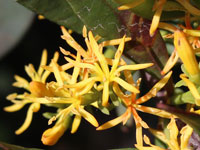
Louisa's Mistletoe
Atkinsonia ligustrina
It's a bush to 2 metres in height. The plants I have found are invariably near an Old Man Banksia (Banksia serrata).
Its 12mm long fruit matures from yellow to crimson.
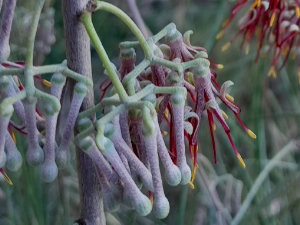
Sheoak Mistletoe
Amyema cambagei
Its terete leaves are up to 15cm long and don't have the segments of its host.
The Malvaceae family includes cotton (Gossypium hirsutum) and the Hibiscus genus.
There's some 25 species of the Malvaceae family in the Blue Mountains across 12 genera including several native hibiscus species.
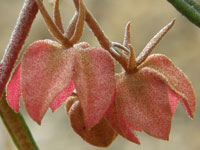
Red Rusty-petals
Lasiopetalum rufum
The leaves (rusty underneath) help proclaim it as a Lasiopetalum species.
Here's another image and another.
The Oleaceae family is also known as the olive family. It includes olive, jasmine, ash and lilac species.
There's some 13 species of the Oleaceae family in the Blue Mountains.
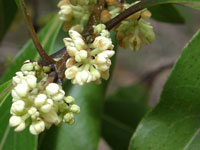
Large Mock-olive
Notelaea longifolia
Also noted are the conspicuous white lenticels - these are pores.
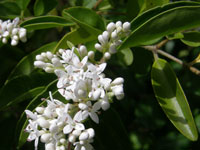
Small-leaved Privet
Ligustrum sinense
Genus Euphrasia - Eyebrights
Formerly included in the Scrophulariaceae family, this semi-parasitic plant's common name of Eyebright refers to the plant's use in treating eye infections.
There's 11 Euphrasia species in NSW, of which 3 are in the Blue Mountains.
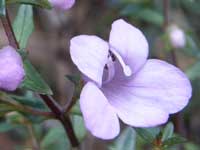
Cliff Eyebright
Euphrasia bowdeniae
It can be distinguished from other members of the genus by its leaves which have one set of "teeth", and its upper leaves are toothless.
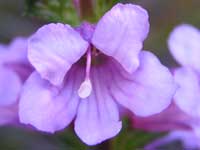
Purple Eyebright
Euphrasia collina subsp. paludosa
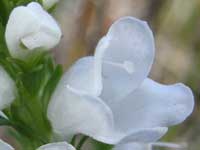
Purple Eyebright
Euphrasia collina subsp. paludosa
Family Phyllanthaceae was formerly part of the Euphorbiaceae family - see NSW Flora Online for more details.
Genus Poranthera
There's 6 Poranthera species in NSW, of which 3 are in the Blue Mountains.
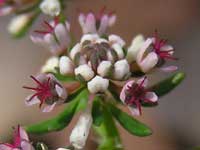
Heath-leaved Poranthera
Poranthera ericifolia
The flower-heads are held at the end of long branching stems and contain both male and female flowers.
The female flowers have red styles.
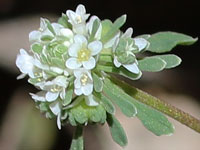
Small Poranthera
Poranthera microphylla
Other genera of the Phyllanthaceae family
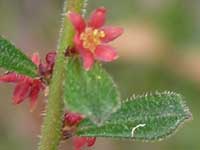
Thyme Spurge
Phyllanthus hirtellus
Family Picrodendraceae was formerly part of the Euphorbiaceae family - see NSW Flora Online for more details.
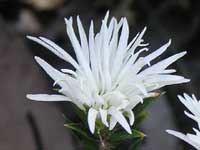
Rice-flower Pseudanthus
Pseudanthus pimeleoides
(The dahlia is Mexico's national flower.)
Flowering in Spring, the flower head contains multiple flowers. The name Rice-flower Pseudanthus is not widely used.
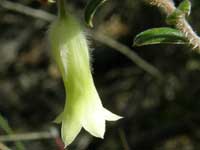
Apple Berry
Billardiera scandens
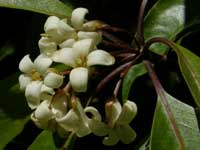
Sweet Pittosporum
Pittosporum undulatum
Also see our Sweet Pittosporum web-page.
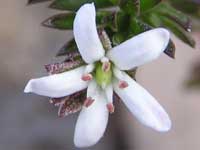
White Marianth
Rhytidosporum procumbens
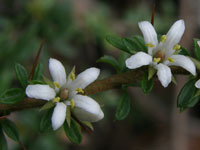
Bursaria longisepala
Flowering in summer, its flowers are 8mm across.
Here's another image.
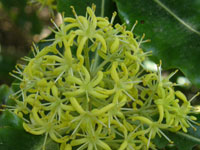
Tarata
Pittosporum eugenioides
Also known as Lemonwood due to the lemon fragrance of its crushed leaves.
Here's another image.
There are five species of this family recorded as being in the Blue Mountains National Park - all are members of the Comesperma genus. Only Mountain Milkwort (C. retusum) has so far alluded me - it looks similar to Matchsticks (C. ericinum) - but its leaves aren't recurved.
The two larger petals on Comesperma species are sepals.
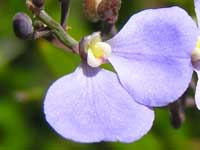
Fairies' Wings
Comesperma defoliatum
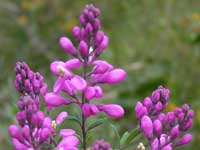
Matchheads
Comesperma ericinum
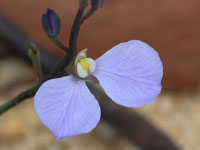
Broom Milkwort
Comesperma sphaerocarpum
Its lateral petals are edged with hairs and it grows in dry sclerophyll forests whereas Fairies' Wings prefers damper places.
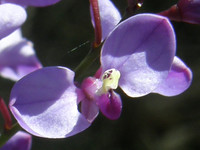
Love Creeper
Comesperma volubile
Its linear leaves are up to 5cm long and 5mm wide.
Here's another image and another.
There are two native species of this family in the Blue Mountains and one weed. Worldwide it includes primroses and cyclamens.
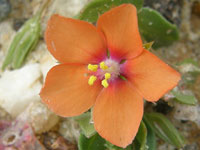
Scarlet Pimpernel
Lysimachia arvensis
It's not stoloniferous - that is, its stems don't produce roots at its nodes.
Here's how in looks from a distance.
Also known as the Blue Pimpernel as it comes in red, pink, orange and blue.
Here's another image and another.
There's several thousand species in the buttercup family (Ranunculaceae) worldwide and includes Ranunculus (buttercups), Clematis, Delphinium (delphiniums) and Helleborus (hellebores) genera. (Personally it seems odd to have clematis and buttercups in the same family).
Genus Clematis
There's eight species of the Clematis genus in NSW with three in the Blue Mountains.
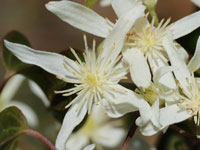
Headache Vine
Clematis glycinoides
Its flowers are 40mm across.
Its leaves have few teeth if any and its anther appendage is < 1mm - compared to Clematis aristata whose leaves are more serrated and an anther appendage > 1mm.
Its fruit has a wispy tail to be taken by the wind.
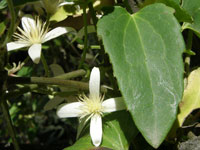
Old Man's Beard
Clematis aristata
Its sepals (not petals) seem to be wider and shorter.
Here's another image.
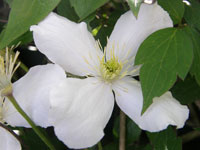
Mountain Clematis
Clematis montana
Its trifoliate leaves distinguish it from the other two Clematis species in the Blue Mountains. It is also deciduous.
Here's another image.
Genus Ranunculus (buttercups)
There's seven Ranunculus species recorded as being in the Blue Mountains with some 4-500 species worldwide.
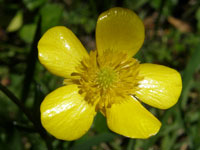
Creeping Buttercup
Ranunculus repens
Here's an image of its leaves.
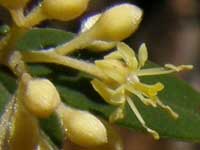
Andromeda Pomaderris
Pomaderris andromedifolia
The name Andromeda Pomaderris is not widely used.
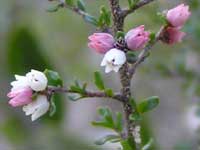
Bitter Cryptandra
Cryptandra amara
Its spine-like branches and 3mm long obovate leaves help identify it.
Its 3mm long flowers start out white, and then become pink, and eventually are a dusky pink with a "red centre".
The family includes the Native Cherry (Exocarpos cupressiformis), the Australian Sandalwood (Santalum spicatum) and Quandong (Santalum acuminatum ). Here's an informative treatment of the Santalum genus.
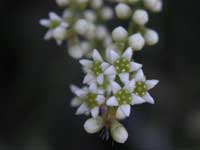
White Sour Bush
Choretrum candollei
Here's an image of the bush.
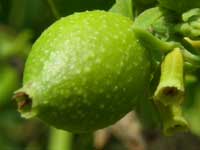
Blunt Sandalwood
Santalum obtusifolium
The images captured here are between flowering in November and maturing of the fruit in late summer. The flowers are white and the mature fruit is purple.
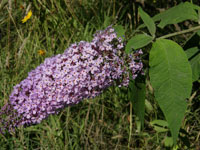
Buddleja
Buddleja davidii
Here's another image.
There are two species of this family in NSW - both of which are in the Blue Mountains.
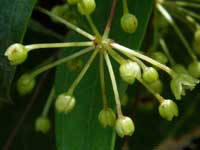
Native Sarsaparilla
Smilax glyciphylla
There are two species of this family in the Blue Mountains.
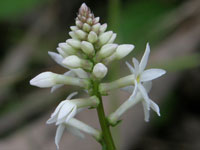
Creamy Candles
Stackhousia monogyna
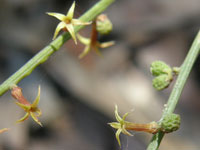
Slender Stackhousia
Stackhousia viminea
Here's another image.
Genus Stylidium - Trigger-plants
There are 11 species of the Stylidium genus in NSW with 4 in the Blue Mountains. Although their flowers look similar, the different species are distinguished by their leaves.
The hammer-like trigger (column) is used to pollinate any insect that lands on the flower.
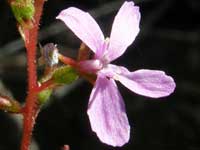
Grass Trigger-plant
Stylidium graminifolium
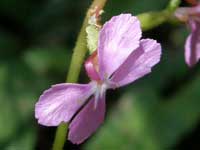
Triggerplant
Stylidium productum
The image shows a flower that has two triggers.
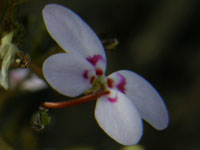
Tree Trigger-plant
Stylidium laricifolium
The colour of the flower varies from nearly white to pink.
The Violet Family includes 900 species of violets and pansies worldwide.
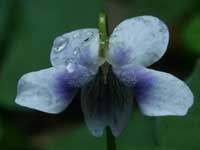
Native Violet
Viola hederacea
Its leaves are variable, and it is best identified by its white and purple flowers - which are 15mm wide.
Here's another image.
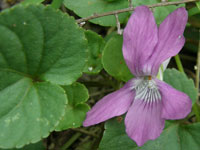
Common Dog-violet
Viola riviniana
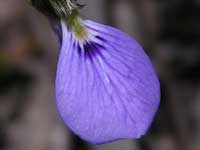
Slender Violet-bush
Hybanthus monopetalus
This species is also known as Lady's Slipper, and its multiple flowers on each stem, distinguishes it from H. vernonii.
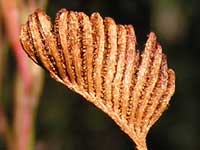
Forked Comb Fern
Schizaea bifida
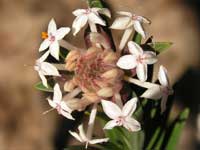
Slender Rice Flower
Pimelea linifolia ssp. linoides
It is also known as Granny's Bonnet.
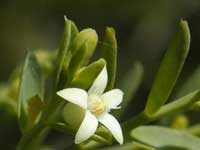
Olax
Olax stricta
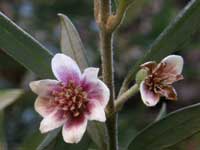
Black Sassafras
Atherosperma moschatum subsp. integrifolium
It is the only species in this genus.
Here's another image.
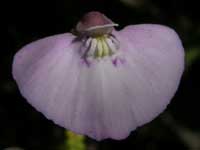
Single Bladderwort
Utricularia uniflora
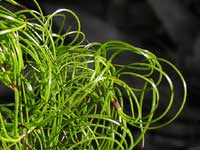
Curly Wig
Caustis flexuosa
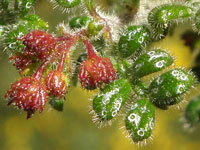
Pinnate Hop Bush
Dodonaea pinnata
Its characteristic seedpod shows it's a hop bush.
Here's an image of its branch and leaves, and another of its flowers.

